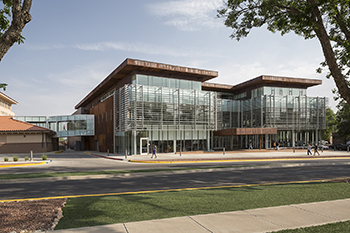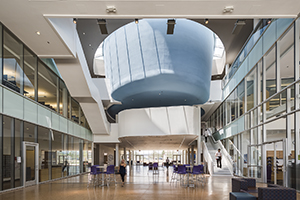Q&A: NMHU Building Earns LEED Gold
 LAS VEGAS, N.M. — The student union building at New Mexico Highlands University recently received LEED Gold certification from the USGBC. Designed by Toronto-based Diamond Schmitt Architects in a joint venture with Studio Southwest Architects of Santa Fe, N.M., the three-story building is the new gateway building to the campus and includes such sustainable design features as a geothermal well system, glazed aluminum curtain wall and one of the first motorized sun tracking louver systems in North America. In this Q&A, Green Building News speaks with Martin Davidson, principal at Diamond Schmitt Architects, about the project and how it achieved its sustainable goals.
LAS VEGAS, N.M. — The student union building at New Mexico Highlands University recently received LEED Gold certification from the USGBC. Designed by Toronto-based Diamond Schmitt Architects in a joint venture with Studio Southwest Architects of Santa Fe, N.M., the three-story building is the new gateway building to the campus and includes such sustainable design features as a geothermal well system, glazed aluminum curtain wall and one of the first motorized sun tracking louver systems in North America. In this Q&A, Green Building News speaks with Martin Davidson, principal at Diamond Schmitt Architects, about the project and how it achieved its sustainable goals.
Q: What are some unique challenges or advantages to green design in Las Vegas, N.M.?
Davidson: With an elevation above 6,400 feet, Las Vegas, New Mexico has four distinct seasons with wide daily temperature variances and heavy snow accumulation. The New Mexico Highlands University Student Union Building is designed to respond to the American Southwest climate and takes full advantage of its setting with an architectural language that reflects materials and elements of the region. A large geothermal well field with two chillers meets all of the building’s heating and cooling needs.
The third floor is set back under large extending roof planes that reduce the overall scale of the building and provide shade and covered terraces. Future green roofs provide rooftop assembly areas with views to the mountains beyond.
Q: Could you describe the benefits of using the motorized sun-tracking louver system?
Davidson: As the motorized louver system is among the first installed in North America, I would single out this prominent feature for innovation on this project. The amount and intensity of sunlight in this area is high. We sought to control the degree to which daylight enters the building with the motorized sun-tracking louver system developed in Germany by Schüco. Mounted on the east, west and south facades, the zoned system operates with independent sensors that monitor temperature, wind, snow and sun angle. The louvers are held 2 feet off the main façade allowing sun shading to extend to within 10 feet of the ground level without compromising transparency and view. The system drastically reduces mechanical loads. Interior electric blinds are user-controlled to address any additional glare from low-angled sun in the winter.
 Q: This building has a very unique exterior. What were some inspirations for the design?
Q: This building has a very unique exterior. What were some inspirations for the design?
Davidson: Above all, transparency was fundamental to the success of this building. It anchors a key intersection where the campus meets the city, so animating this gateway with visible activity both in the commercial space at grade and student space above it creates a welcoming beacon.
Las Vegas has a fascinating architectural richness with strong influences in material and design from the eastern U.S. from a time when this was an important commercial center for transcontinental trade. Additionally, the Southwestern influence is prominent in terra cotta structures that have small openings and large walls — a direct response to the climate.
In using brick, we paid homage to the tradition of masonry brought from the east. The Cor-Ten panels on the exterior and stucco, which appears on the floating student chamber drum in the atrium, both recognize the influence of more traditional New Mexican culture and materials.
Q: As a designer, what have you taken away from this project that you might use in future projects?
Davidson: Diamond Schmitt Architects has 20 LEED certified projects. Each has its own unique design solutions based on the client’s ambition, the potential of the site as well as the climate. New Mexico Highlands University was an engaged client interested in pursuing innovative solutions to sustainable design. The exploration of these factors can lead the architect and collaborators to unexpected strategies in response to sustainable outcomes. This project reinforces the requirement to enter projects — especially those with a sustainable agendas — without preconceived ideas.
